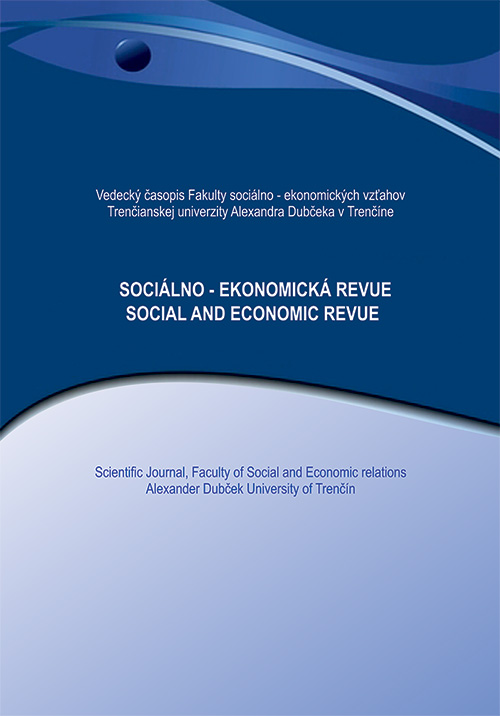THE BUREAUCRAT IN THE 21ST CENTURY THROUGH THE EYES OF HIS CLIENTS
The public sector is one of the main pillars of a mixed economy. At the same time, its activities significantly contribute in running and functioning of the State. of the world. At the same time, the trust that citizens of the State in question show to public institutions, institutes and their representatives cannot be overlooked. For this reason, an employee is a key consideration. The aim of this article is to provide an up-to-date view of human resources issues in the public sector. Among the wide apparatuses, we decided to focus attention especially on the area of the administrative apparatus, its attitude and relation to work, as well as possible areas of development. For this purpose, we have used several research methods. We can mention the method of analysis, synthesis, comparison, questionnaire investigation, interview, deduction and so on. These methods have helped us to achieve our goal and formulate recommendations based on our findings.
Release: 2019/2 Pages: 80-88 JEL classification: H70, H83, D73
DOI:
Keywords: Bureaucracy, Client, ESO reform, Public Service, State
Section: PUBLIC ECONOMICS AND PUBLIC ADMINISTRATION, REGIONAL DEVELOPMENT
Contacts:
Martina, Jakubcinova, Ing., PhD., MBA
Alexander Dubcek University of Trencin,
Department of Public Administration and Regional Economy
Studentska 2, 911 50 Trencin
martina.jakubcinova@tnuni.sk
Ján, Kútik, doc. Ing., CSc.
Alexander Dubcek University of Trencin,
Department of Public Administration and Regional Economy
Studentska 2, 911 50 Trencin
Literature:
Berkley, G. E. (1975). Thecraft of publicadministration. Boston: Allyn and Bacon, 1975. 504 p.
Braithwaite, V. (2007). Responsive Regulation and Taxation: Introduction. Law and Policy. 29(1), 3–10.
Čapošová, E. (2013). Súčasné trendy riadenia ľudských zdrojov a ich význam vo verejnej správe. Sociálno-ekonomická revue. 2013(3), 24-30.
Dobrý úradník. (2019). Desatoro dobrého úradníka. [on-line] [cit.: 2019-15-08]. Retrieved from: https://docs.wixstatic.com/ugd/1346c2_28ef637a029748b4aae663900f0c2a10.pdf
European Union (2017). Quality of Public Administration – A Toolbox for Practitioners. Luxembourg: Publshions Office of the European Union, 2017. p.18.
Eurostat (2018). Employmentstatistics. [on-line] [cit.: 2019-15-08]. Retrieved from: https://ec.europa.eu/eurostat/statistics-explained/index.php?title=Employment_statistics
Hajšová, M., význam ľudského kapitálu pre rozvoj samosprávy. Sociálno-ekonomická revue. 2014(2), 6-11.
Homberg, F. (2019). Public service motivation and continuous organizational change: Taking charge behavior at polce services. PublicAdministration. 97(1). 28-47.
IFAC (2013). The 2013 Annual Review. [on-line] [cit.: 2019-15-08]. Retrieved from: https://www.ifac.org/system/files/publications/files/IFAC-2013-Annual-Review.pdf
Janečková, T. (2018). Seminár „Ako zvýšiť kvalitu slovenských úradníkov“ [on-line] [cit.: 2019-15-08]. Retrieved from: https://transparency.sk/sk/ako-zvysit-kvalitu-slovenskych-uradnikov/
Johnson, D. B. (1997). Teória verejnej voľby. Úvod do novej politickej ekonómie. Bratislava: SOFA, 1997. 353 p.
Klimovský, D. (2014). Základy verejnej správy. Bratislava: Wolters Kluwer, 2014. 456 p.
Križanová, Z., Kútik. J. (2017). Human Resources in the management of Flood Situation in the Slovak Republic. Sociálno-ekonomická revue. 2017(4), 15-21.
Matoušek, O. (2013). Metody a řízení sociální práce. Praha: Portál, 2013. 380 p.
Milkovich, G. T., Boudreau, J. W. (1993). Řízení lidských zdrojů. Praha: Grada, 1993. 930 p.
Moon, M. J. (2002). The Evolution of E-Government among Municipalities: Rhetoric or Reality? Public Administration Review. 62(4), 424–433.
Mzee (2012). TheContext of Globalization and Human Resource Need and Strategy for Developing Countries, intech – open sciene, open minds. [on-line] [cit.: 2019-15-08]. Retrieved from: https://www.intechopen.com/books/globalization-education-and-management-agendas/
Needham, C. E. (2006). Customer Care and the Public Service Ethos. Public Administration. 84(4), 845–860.
Vojtovič, S. (2011). Koncepce personálního řízení a řízení lidských zdrojů. Praha: Grada, 2011. 192 p.
Wright, G., Němec, J. (2003). Management veřejné správy. Teorie a praxe. Praha: Ekopress, 2003 .419 p.
Zákon č. 177/2018 Z. z. o niektorých opatreniach na znižovanie administratívnej záťaže využívaním informačných systémov verejnej správy a o zmene a doplnení niektorých zákonov
Zákon č. 552/2003 Z. z. o výkone práce vo verejnom záujme


